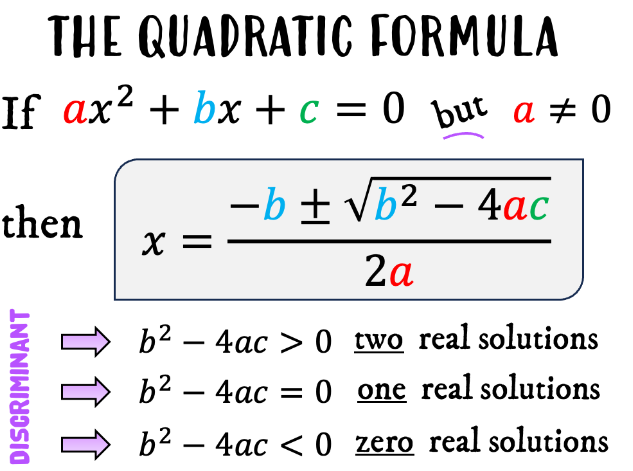The Importance of Quadratic Equations for Programmers
Unveiling the Significance of Quadratic Equations
Quadratic equations, often perceived as a mathematical abstraction, hold surprising relevance for programmers and aspiring IT professionals. In this article, we’ll unravel the importance of quadratic equations in the world of technology and programming, exploring the standard form, hidden applications, the quadratic formula, discriminant, and a step-by-step solution for a real-world example – 4x ^ 2 – 5x – 12 = 0.

The Standard Form
Let’s begin with the foundational concept of the standard form of a quadratic equation:
ax ^ 2 + bx + c = 0, where a, b, and c are real numbers. The roots of this equation, often referred to as x-intercepts, are given by:
x_1 = -b/2a and
x_2 = -b/2a
Hidden Quadratic Equations!
While quadratic equations may not always surface in everyday programming tasks, they discreetly influence various algorithms and mathematical models. These ‘hidden’ quadratics can impact the performance and efficiency of systems and software, making a comprehensive understanding of quadratic equations indispensable for IT professionals.
About the Quadratic Formula
In the context of programming and IT, the quadratic formula serves as a valuable tool for solving quadratic equations. It enables the determination of roots, which are solutions satisfying both sides of the equation. Of particular significance is the discriminant, denoted as b^2 – 4ac, which plays a pivotal role in assessing the nature of the solutions.
Discriminant
The discriminant is a crucial element in the world of programming and IT. When it’s positive, it signifies the presence of two real solutions; when negative, it implies complex solutions. Understanding the discriminant can guide decisions regarding system behavior, data analysis, and more.
Using the Quadratic Formula
Here’s a step-by-step guide to applying the quadratic formula:
Step 1: Identify the Coefficients Start by identifying the coefficients in the given equation. In the case of 4x ^ 2 – 5x – 12 = 0:
- a = 4
- b = -5
- c = -12
Step 2: Apply the Quadratic Formula The quadratic formula is expressed as:
x = (-b ± √(b^2 – 4ac)) / 2a
Step 3: Calculate the Discriminant To determine the nature of the solutions, compute the discriminant, b^2 – 4ac:
- b^2 – 4ac = (-5)^2 – 4 * 4 * (-12)
- b^2 – 4ac = 25 + 192
- b^2 – 4ac = 217
Step 4: Find the Roots Now, utilize the quadratic formula with the discriminant value:
- x = (-(-5) ± √217) / 2 * 4
- x = (5 ± √217) / 8
The Importance for Programmers
Quadratic equations, although seemingly distant from the daily tasks of a programmer, hold a surprising level of importance in the world of software development and problem-solving. Here’s why understanding and being able to work with quadratic equations is crucial for programmers:
1. Algorithm Optimization: Quadratic equations often find their way into algorithms, especially in the context of optimization problems. A programmer who is proficient in solving quadratic equations can create more efficient algorithms for tasks like data analysis, image processing, or numerical optimization.
2. Modeling Real-World Scenarios: In the field of programming, particularly in game development, physics simulations, and scientific software, quadratic equations are commonly used to model real-world scenarios. This could involve calculating the trajectory of a projectile, predicting the behavior of physical systems, or simulating dynamic behaviors, where quadratic equations play a fundamental role.
3. Error Analysis: Quadratic equations can provide insight into error analysis and signal processing. Understanding how to manipulate and analyze quadratic equations is essential when working with data that might contain measurement errors, noise, or anomalies. This knowledge can help in data smoothing and error correction techniques.
4. Predicting System Behaviors: In the world of IT, predicting system behaviors is critical for maintaining reliable and efficient software. Quadratic equations can help in analyzing performance data and predicting system behavior, aiding in capacity planning and resource allocation.
5. Data Fitting and Regression: Quadratic equations are often used in data fitting and regression analysis. When programmers need to fit a curve to a set of data points, quadratic equations come into play. This is essential for tasks such as trend analysis, predictive modeling, and machine learning, which are all vital components of the IT and data science domains.
6. Troubleshooting and Debugging: In some cases, quadratic equations may inadvertently make their way into code. Understanding how to recognize and deal with these equations is crucial for troubleshooting and debugging when issues arise. The ability to identify and correct problems related to quadratic equations can save time and improve code reliability.
7. Expanding Problem-Solving Skills: Quadratic equations provide a unique problem-solving challenge. Learning how to approach and solve these equations enhances a programmer’s problem-solving skills. This aptitude can extend beyond quadratic equations and be applied to a wide range of challenges encountered in software development.
While quadratic equations may not be the centerpiece of a programmer’s toolkit, they play a vital role in various aspects of programming, data analysis, and problem-solving. Being proficient in working with quadratic equations empowers programmers to optimize algorithms, model real-world scenarios, analyze data, and make more informed decisions in the world of technology.






